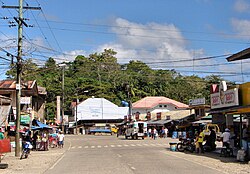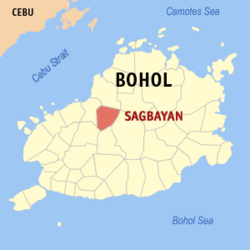Sagbayan Barangayes Historia Referencias Menú de navegación9°55′00″N 124°06′00″E / 9.9166666666667, 124.19°55′00″N 124°06′00″E / 9.9166666666667, 124.1Executive Order No. 204, s. 1949 | Official Gazette of the Republic of the Philippines: ORGANIZING CERTAIN BARRIOS AND SITIOS OF THE MUNICIPALITIES OF CLARIN, INABANGA AND BALILIHAN, PROVINCE OF BOHOL, INTO AN INDEPENDENT MUNICIPALITY UNDER THE NAME OF BORJA.
Localidades de Bohol
municipioprovinciaBoholFilipinasColinas de Chocolatebarangayes9 de febrero1949ClarinInabangaBalilihanBorjaSagbayán
| Sagbayan | ||
|---|---|---|
Municipio | ||
 | ||
 Sagbayan Localización de Sagbayan en Filipinas | ||
 Ubicación de Sagbayan en Bohol | ||
| Coordenadas | 9°55′00″N 124°06′00″E / 9.9166666666667, 124.1Coordenadas: 9°55′00″N 124°06′00″E / 9.9166666666667, 124.1 | |
| Entidad | Municipio | |
| • País | ||
| • Región | Bisayas centrales | |
| • Provincia | Bohol | |
| Superficie | ||
| • Total | 69,61 km² | |
Población (1 de agosto de 2015) | ||
| • Total | 22 339 hab. | |
| • Densidad | 320,92 hab/km² | |
| Huso horario | UTC +8 | |
| Código postal | 6331 | |
| Prefijo telefónico | 38 | |
 | ||
Sagbayan es un municipio de la provincia de Bohol en Filipinas. Según el censo del 2007, tiene 19 399 habitantes. La localidad es una de las donde se encuentran las Colinas de Chocolate.
Barangayes
Sagbayan se divide administrativamente en 24 barangayes.
|
|
Historia
El 9 de febrero de 1949 los barrios de Sagbayan, Canmaya Centro, Canmaya Diot, Canmano, San Antonio y San Isidro, así como los sitios de Santa Cruz, San Vicente Norte, San Vicente Sur, San Ramon y Kalangahan, que hasta ahora formaban parte del municipio de Clarin; los sitios de Mantalongon y de Katipunan, hasta ahora de Inabanga; y los sitios of Cabasacan y de Ubuhan, hasta ahora de Balilihan, pasan a integrar el nuevo municipio de Borja con sede en el barrio de Sagbayán.[1]
Referencias
↑ Executive Order No. 204, s. 1949 | Official Gazette of the Republic of the Philippines: ORGANIZING CERTAIN BARRIOS AND SITIOS OF THE MUNICIPALITIES OF CLARIN, INABANGA AND BALILIHAN, PROVINCE OF BOHOL, INTO AN INDEPENDENT MUNICIPALITY UNDER THE NAME OF BORJA.